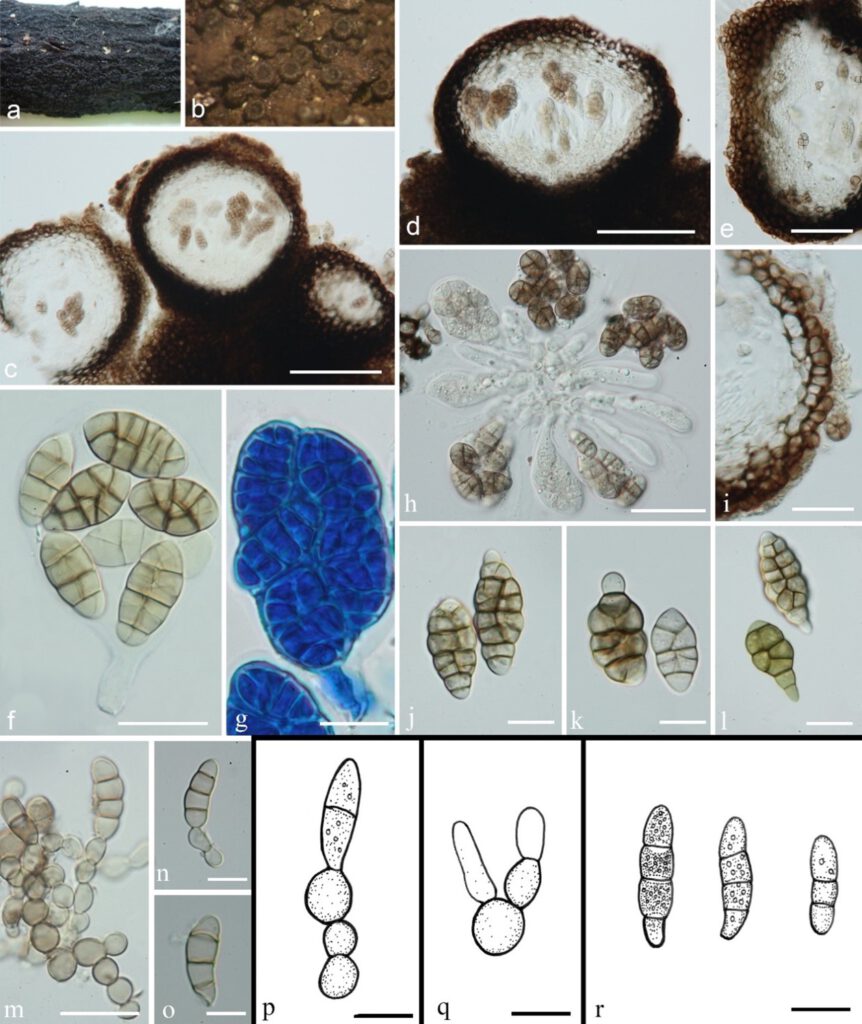Coccodinium bartschii A. Massal., Atti Inst. Veneto Sci. lett., ed Arti, Sér. 3 5: 336 (1860) [1859-1860], Figure 17
MycoBank number: MB 153614; Index Fungorum number: IF 153614; Facesoffungi number: FoF 10353;
Epiphytic or biotrophic on the branches of Quercus macrocarpa as sooty molds and mostly adpressed to the surface of branches gaining nutrients from sugary exudates of sap-feeding insects. Subiculum well-developed, superficial, loose, comprising effuse, branched, blackish brown, septate hyphae. Sexual morph: Ascomata 220–350 μm high × 120–300 μm diam. (x̅ = 305 × 245 μm, n = 10), superficial, sessile on subiculum developing on the surface of the branch, perithecial, scattered to aggregated, globose to subglobose, circular when mature, cupulate when dry, uniloculate, brown to dark brown, with periphysate ostioles, with or without papillate, thick-walled, setose at times. Wall of ascoma 18–32 μm (x̅ = 25 μm, n = 10), thicker at the apex and base, multi-layered, externally comprising pigmented, dark brown, thick-walled cells of textura angularis, with inner layer thinner, composed of irregularly-shaped, flattened, lightly pigmented to hyaline, thin-walled cells of textura prismatica. Hamathecium lacking paraphyses, with numerous periphyses near the ostiole. Asci 48–52 × 13–17 μm (x̅ = 48 × 15.8 μm, n = 10), 8-spored, bitunicate, fissitunicate, saccate, broadly clavate, shortly pedicellate, lacking a distinct ocular chamber. Ascospores 18–27 × 3–5 μm (x̅ = 24 × 4.2 μm, n = 10), overlapping bi-seriate or multi-seriate, irregularly arranged, ellipsoidal or clavate, fusiform, hyaline to brown, muriform, with 2–4 transverse septa, 1–2 longitudinal septa in the middle cells and sometimes 1–2 longitudinal septa at end cells, constricted at the septum, smooth and thick-walled, lacking a gelatinous sheath or appendages. Asexual morph: hyphomycetous. Hypha comprising of brown, globose cells, giving rise to indistinct phialides with 1–3 conidia. Conidiogenous cell 3–8 μm in diam. (x̅ = 6 μm, n = 10), phialidic, globoid to oblong, subhyaline to pale brown, smooth-walled. Conidia 15–22 × 5–9 μm (x̅ = 18 × 6 μm, n = 10), fusoid-ellipsoidal to clavate, widest in the upper third of the conidium, apex obtuse, base subtruncate, lightly pigmented to brown, 3–5-septate, constricted at the septa, smooth-walled, guttulate.
Material examined: Canada, Ontario, on a dead fallen branch of Quercus macrocarpa Michx. (Fagaceae), 19 July 1994, S. J. Hughes (ex herb IMI 370066).

Figure 17 Coccodinium bartschii (IMI 370066). a, b Ascomata on the superficial of host. c, d Vertical sections of ascomata. e Vertical section through ostiole. f–h Asci with ascospores. i Vertical section through ascoma wall. j–l Ascospores. m, n Conidiogenous cell giving rise to conidia. o Conidium. p–r Redrawn from Crous et al. 2007a, p, q show conidiogenous cell with conidia, r shows conidia. Scale bars: c, d = 100 µm, e, h, i = 50 µm, f, m = 20 µm, g, j–l, n–r = 10 µm.
